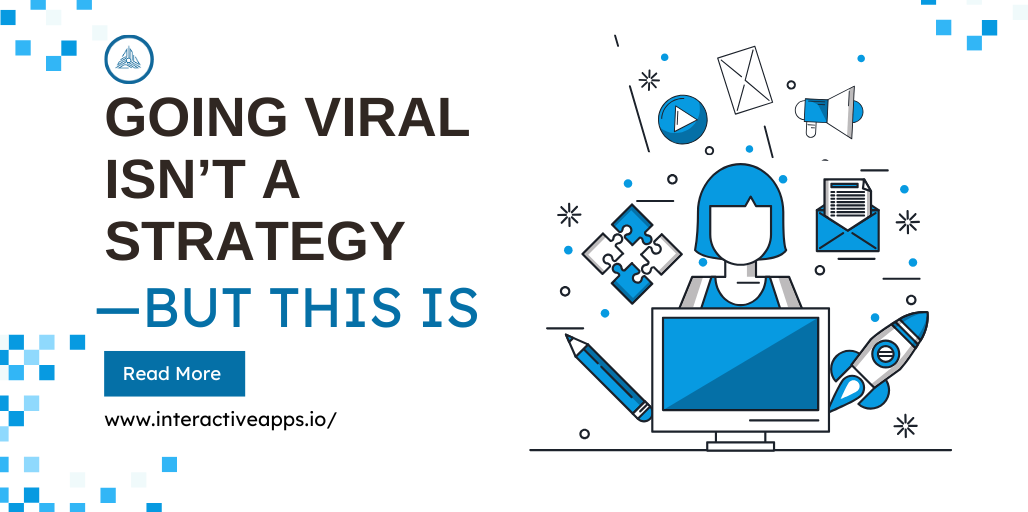“We just need to go viral.”
That sentence has floated through boardrooms, Slack messages, and marketing brainstorms more times than anyone can count. It sounds like a winning idea—because who wouldn’t want a million eyeballs on their brand overnight? But chasing virality as a plan is like buying lottery tickets and calling it retirement planning.
This piece isn’t here to mock the dream of breakout success. It’s to make a simple case: Virality is an outcome, not a blueprint. And real, repeatable growth? That comes from something far less glamorous—consistency, clarity, and patience. Let’s dig into the truth of what actually works, with the facts and numbers that bring it all home.
The Mirage of Going Viral
Virality has a highlight reel. Remember the “Ice Bucket Challenge”? How about the guy skateboarding to Fleetwood Mac while sipping cranberry juice? These are internet gold mines, sure. But they’re one in a million—literally.
According to research from Backlinko, only 1.1% of YouTube videos get more than a million views. On TikTok, the platform built for fast fame, only 0.003% of videos truly go viral (as in, reach tens of millions). That’s the same odds as getting struck by lightning twice.
In short, trying to go viral is like aiming at a moving target in the dark. It might happen, but you can’t bank on it. And if that’s the whole plan? You’re gambling with time and money.
The Problem With Virality as a Goal
No Control, No Compass
Virality depends on shareability, not substance. The thing that spreads fastest is rarely the thing that lasts. A spike in attention might give a business a brief sugar high, but it usually fades in days, if not hours. Unless there’s something underneath—a strong product, a story worth following, a brand people trust—the crowd moves on.
Audience vs. Community
A viral post might bring traffic. It might even bring sign-ups or downloads. But if those people don’t stick around? It’s hollow. A study by HubSpot found that while a viral hit can boost traffic by 400% for a day, conversion rates often dip during these spikes because the audience isn’t targeted. They came for the laugh, not the offer.
What Actually Works: Building Trust, Bit by Bit
If virality is the fireworks, what’s the slow burn that actually keeps things alive? Here’s the strategy that wins—not just once, but over and over.
H2: Tell the Truth, Often
Clarity Over Cleverness
Brands that win are brands that are clear. Not cute. Not clever. Just honest. Whether it’s a newsletter, product page, or social post—clarity makes people stop scrolling. According to MarketingExperiments, rewriting a headline to make it clearer (not funnier) can boost conversion rates by over 60%.
Say It Again
The average person needs to see a message 7 times before it sticks. That’s not a guess—it’s backed by research from Dr. Jeffrey Lant, who studied marketing frequency and recall. Want people to remember you? Say the same thing, a bunch of times in different ways. Over months. Not minutes.
H2: Serve Before You Sell
Give People What They Need
Brands that help win. Whether it’s solving a problem, explaining a process, or just making someone’s day easier, useful content gets remembered. A report by Demand Metric found that 82% of consumers feel more positive about a brand after reading custom content. Not ads. Not clickbait. Just helpful, specific content.
Education Beats Entertainment (Long-Term)
A funny video might get a share. A tutorial that actually solves a problem might get a customer for life. In one Conductor study, users who read educational content were 131% more likely to buy than those who didn’t.
H2: Talk to People Like a Human
The Brands People Trust Sound Real
No brand was ever loved because it sounded like a corporation. The best ones talk like people. Look at the success of companies like Duolingo or Liquid Death. Both built massive followings not through gimmicks but by showing personality—and talking like actual humans. It’s not about tone; it’s about realness.
A Sprout Social report showed that 86% of consumers prefer brands that are honest and authentic on social media. The world doesn’t need another brand “engaging” with emojis. It needs real stories told plainly.
H2: Do One Thing Well, Then Repeat
Don’t Try to Be Everywhere
A common trap is trying to be on every platform, every trend, every time. But here’s the kicker: 80% of engagement often comes from one channel. Pareto’s Principle applies here 20% of effort drives 80% of the result. Find your 20%. Lean into it.
Example: Morning Brew built a $75M media brand with just one great newsletter. No gimmicks. No viral stunts. Just smart writing, every morning, for a specific audience.
Frequency Builds Familiarity
A Harvard Business Review article once put it this way: familiarity breeds trust. And trust breeds action. Show up consistently. Even when it’s quiet. Even when it feels like no one’s watching. Because someone always is.
H2: Play the Long Game
Compound Interest Works in Content, Too
The internet rewards consistency. Not flash. A blog post written today could bring in traffic for five years. A YouTube video might get more views in month six than in month one. According to Ahrefs, 90.63% of content gets no traffic from Google. The stuff that does? It often took months, even years, to grow.
Patience Pays, Literally
A brand that grows slowly, on purpose, often makes more money over time than one that spikes and crashes. Basecamp, for example, never raised money, never chased trends—and still runs a multi-million dollar business. Their secret? Doing simple things well, for a long time.
H2: Focus on Real Metrics, Not Vanity Numbers
Views Don’t Pay the Bills
A post with 100,000 views feels good. But if none of those viewers become customers, it’s just noise. ProfitWell data shows that engagement with product-focused content—demos, use cases, testimonials—leads to 4x higher conversion rates than general interest content.
Track What Matters
Instead of chasing views, likes, or shares, track retention, referrals, and revenue. That’s where the truth lives. Growth isn’t a number on a dashboard. It’s someone coming back, again and again, because they trust what’s being offered.
H2: The Underrated Power of Word of Mouth
What People Say Matters More Than What You Post
According to Nielsen, 92% of people trust recommendations from friends and family over any form of advertising. That makes real word of mouth more powerful than any ad campaign.
So how do you earn it? Make something worth talking about. Surprise someone. Solve a real problem. Then, ask them to tell others.
Small Movements Become Big Ones
You don’t need a million fans. You need a hundred people who care deeply. A thousand who’ll tell five friends. Growth from the ground up is slower—but it sticks. Seth Godin calls this the “tribe” model. Not chasing the masses, but gathering the few who care most.
Real-World Examples That Prove the Point
Notion:
Built its brand by giving power users what they wanted. Focused on tutorials, templates, and community before even spending on ads. Their Reddit community grew 200% in a year just from peer-to-peer help and content.
Calendly:
No viral launches. Just product-led growth. People booked a meeting, liked the experience, and started using it themselves. Over 10 million users now. Quiet growth, loud impact.
Glossier:
Built from a blog. Not a billboard. Founder Emily Weiss started with content, not a product. And when the product came, the readers turned into buyers. A $1B valuation followed. But the roots were small. And slow.
So, What’s the Strategy?
It’s not magic. It’s not luck. It’s not the algorithm.
It’s showing up. Saying something true. Solving a problem. Saying it again. Listening. Adjusting. And doing it every week for years. That’s how trust is built. That’s how growth sticks. That’s how movements start.
Virality might still happen along the way. And if it does? Great. But that’s not the goal. The goal is resilience. Reputation. Results that outlive the moment.
Final Thoughts
It’s tempting to chase what’s flashy. But what’s real is always quieter. Strong brands grow like oak trees—not weeds. Slow roots. Wide branches. Decades of shade. So, no, going viral isn’t a strategy.
But showing up with a purpose every day? That is.



